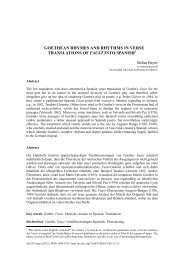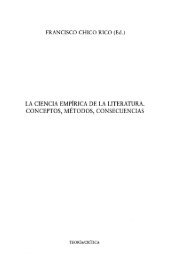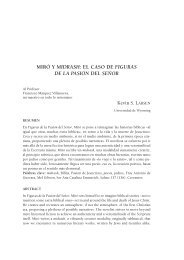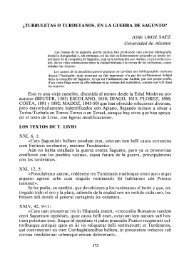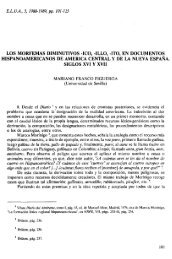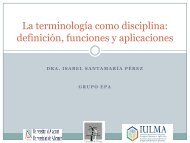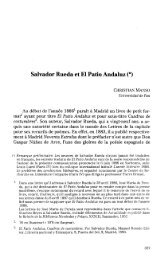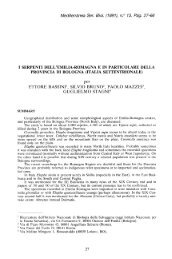Conceptual Metaphors in Taboo-Induced Lexical Variation
Conceptual Metaphors in Taboo-Induced Lexical Variation
Conceptual Metaphors in Taboo-Induced Lexical Variation
Create successful ePaper yourself
Turn your PDF publications into a flip-book with our unique Google optimized e-Paper software.
<strong>Conceptual</strong> <strong>Metaphors</strong> <strong>in</strong> <strong>Taboo</strong>-<strong>Induced</strong> <strong>Lexical</strong> <strong>Variation</strong> 55<br />
approach, which, as Bald<strong>in</strong>ger (q. <strong>in</strong> Geeraerts 2009: 653) argues, focuses on the<br />
“designations of a particular concept”, that is, the actual lexical choices for a given (<strong>in</strong><br />
our case taboo) referent <strong>in</strong> a given situation.<br />
This paper is structured as follows. After briefly deal<strong>in</strong>g with the theoretical<br />
framework this study relies on and how figurative language manipulates taboo<br />
referents, I will analyse the role that the process of lexicalization plays <strong>in</strong> euphemistic<br />
and dysphemistic figurative language <strong>in</strong> the taboos area of sex and death. The<br />
conclusions and the f<strong>in</strong>al results obta<strong>in</strong>ed from the analysis will br<strong>in</strong>g this study to an<br />
end.<br />
2. Theoretical assumptions<br />
As already mentioned, the theoretical assumptions on which the present study relies are<br />
derived from the well-known cognitive model of <strong>Conceptual</strong> Metaphor Theory<br />
(hereafter CMT), <strong>in</strong>itially developed by Lakoff and Johnson <strong>in</strong> their sem<strong>in</strong>al work<br />
<strong>Metaphors</strong> We Live By (1980). Lakoff and Johnson revealed the centrality of metaphor<br />
to thought tak<strong>in</strong>g as examples metaphorical forms <strong>in</strong> everyday language. They claimed<br />
that we talk about th<strong>in</strong>gs the way we conceive them, and this is grounded <strong>in</strong> our<br />
experience and culture. From this standpo<strong>in</strong>t, metaphor is def<strong>in</strong>ed as “a cross-doma<strong>in</strong><br />
mapp<strong>in</strong>g <strong>in</strong> the conceptual system” (Lakoff, 1993: 203); that is, a mapp<strong>in</strong>g or set of<br />
conceptual correspondences from a source doma<strong>in</strong> (the realm of the physical or more<br />
concrete reality) to a target doma<strong>in</strong> (the more abstract entity, <strong>in</strong> our case, sex and deathrelated<br />
concepts). The source doma<strong>in</strong> is therefore used to understand, structure and,<br />
depend<strong>in</strong>g on the speaker’s <strong>in</strong>tention, mitigate or re<strong>in</strong>force the associations of a<br />
negative k<strong>in</strong>d of the target doma<strong>in</strong>.<br />
Therefore, with<strong>in</strong> the cognitive tradition, metaphor is understood as a device with<br />
the capacity to structure our conceptual system, provid<strong>in</strong>g, at the same time, a particular<br />
understand<strong>in</strong>g of the world and a way to make sense of our experience. Hence, the<br />
metaphor is, as Lakoff and Turner (1989: xi) claim, rather than a l<strong>in</strong>guistic expression<br />
or a figure of speech with an aesthetic value, a mode of thought and reason:<br />
Far from be<strong>in</strong>g merely a matter of words, metaphor is a matter of thought – all k<strong>in</strong>ds of<br />
thought: thought about emotion, about society, about human character, about language,<br />
and about the nature of life and death. It is <strong>in</strong>dispensable not only to our imag<strong>in</strong>ation, but<br />
also to our reason.<br />
Despite the close l<strong>in</strong>ks between metaphors and X-phemistic processes, cognitive issues<br />
have been largely excluded from the study of euphemism and dysphemism, which have<br />
been analysed from different l<strong>in</strong>guistic discipl<strong>in</strong>es such as lexical semantics,<br />
sociol<strong>in</strong>guistics, rhetoric and, more recently, pragmatics (cf. Casas Gómez, 2009: 725-<br />
739). As euphemism and dysphemism can be accurately and <strong>in</strong>sightfully described <strong>in</strong><br />
terms of cognitive abilities, Casas Gómez has def<strong>in</strong>ed X-phemistic processes with<strong>in</strong> the<br />
general framework of l<strong>in</strong>guistic <strong>in</strong>terdiction from a cognitive po<strong>in</strong>t of view. This scholar





